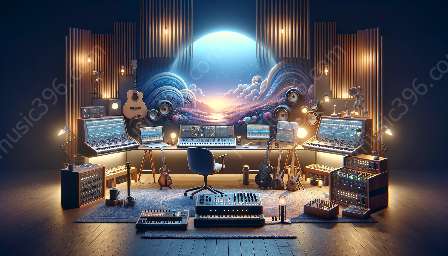MIDI (Musical Instrument Digital Interface) has revolutionized the way musicians and producers interact with technology, serving as a versatile tool for controlling external hardware in music production and notation. This topic cluster delves into the applications of MIDI in these areas, exploring its impact on music composition, performance, and technology.
MIDI and Music Production
MIDI is crucial in the world of music production as it allows for seamless integration of external hardware into digital audio workstations (DAWs). Whether it's synthesizers, drum machines, or effects processors, MIDI enables musicians and producers to control and synchronize these devices with unparalleled precision.
Controlling Synthesizers
One of the most common uses of MIDI in music production is for controlling synthesizers. Through MIDI, parameters such as pitch, volume, and modulation can be adjusted in real time, offering a level of expressiveness and dynamic control that goes beyond what is possible with traditional analog interfaces.
Integration with DAWs
Furthermore, MIDI facilitates seamless integration with DAWs, allowing for the recording and playback of MIDI data alongside digital audio tracks. This integration enables musicians to harness the full potential of both hardware and software instruments, creating rich and complex musical arrangements with ease.
Drum Machines and Rhythm Controllers
Another application of MIDI in music production is the control of drum machines and rhythm controllers. By sending MIDI signals, users can trigger drum sounds, sequence patterns, and create complex rhythmic arrangements, all while maintaining precise synchronization with other elements of the production.
MIDI and Music Notation
Aside from its role in music production, MIDI also plays a crucial role in music notation, offering a powerful means of representing musical scores and facilitating the exchange of musical data in a digital format.
Score Editing and Playback
With MIDI-compatible notation software, composers and arrangers can edit and playback musical scores with unparalleled flexibility. MIDI data allows for the precise representation of note durations, dynamics, and articulations, providing a comprehensive platform for creating and sharing musical compositions.
Interactive Learning Tools
Moreover, MIDI-based notation software provides interactive learning tools that aid in music education, offering features such as visual feedback, practice modes, and adaptive scoring that enhance the learning experience for students and musicians of all levels.
Impact on the Musical Instrument Digital Interface
The utilization of MIDI for controlling external hardware has significantly impacted the evolution of the Musical Instrument Digital Interface, expanding its capabilities and shaping the future of music technology.
Advancements in MIDI Connectivity
As the demand for more advanced MIDI control and connectivity grows, manufacturers have developed innovative hardware solutions that cater to the needs of modern musicians and producers. This includes MIDI controllers, interfaces, and protocol advancements that streamline the integration of external hardware into musical workflows.
Enhanced Interoperability
Additionally, the use of MIDI for controlling external hardware has driven enhanced interoperability between various musical devices, enabling seamless communication and synchronization across different platforms and systems. This interoperability fosters a collaborative environment for musicians and producers, empowering them to explore new creative possibilities.


